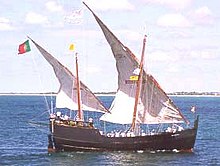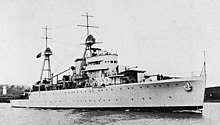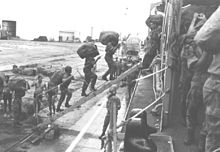Marinha Portuguesa
|
Portuguese Navy |
|
|---|---|
| Lineup | Late 12th century |
| Country |
|
| Armed forces | Portuguese Armed Forces |
| Type | Armed forces ( navy ) |
| headquarters | Lisbon |
| management | |
| Chefe do Estado-Maior da Armada e Autoridade Marítima Nacional (CEMA-AMN) | Admiral António Maria Mendes Calado |
| insignia | |
| Naval war flag |
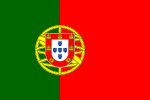
|
| Gösch |

|
| Command flag |

|
The Marinha Portuguesa (German Portuguese Navy ) is the naval force of the Republic of Portugal and one of four branches of the Portuguese armed forces . It has a staff of (2011) around 10,400 men and women, including a good 10% officers and including around 1,500 members of the marine infantry .
History of the Portuguese Navy
The Portuguese Navy, which emerged in the late Middle Ages , contributed significantly to the development of a modern European view of the world with its voyages of discovery . At the beginning of modern times, the Portuguese seafaring experienced its heyday and elevated Portugal to an important seafaring nation or colonial power. The voyages of discovery by Vasco da Gamas and other Portuguese sailors became the subject of the Portuguese national epic " The Lusiads ". From then on, the fleet served primarily to secure the Portuguese colonial empire and fell into disrepair with the collapse of the same.
Beginnings
The establishment of a Portuguese navy began under King Dinis I (1261 / 1279-1325). Portugal's first king Afonso I (1109 / 1128–1185) needed the help of Bremen ships and English crusaders for the conquest of Lisbon in 1147 , but already under his great-grandson, Dinis' father Afonso III. (1210 / 1248–1279), Portuguese ships had also helped blockade and conquer the last Moorish port cities and coastal towns on the Algarve between 1237 and 1250 .
The conquest of Badajoz (1230) and Niebla (1262) by Castile as well as permanent border treaties (1267, 1297) prevented Portugal from expanding on land, expansion was only possible at sea. In addition, Portugal was cut off from the rest of Europe by Castile and Spain, respectively, and its English allies and Flemish and Italian trading partners could only be reached by sea. These sea routes, in turn, but also the Portuguese fishing interests were threatened by Castile and Spain and its allies as well as by Moorish pirates.
Not only the need for a fleet, but above all the possibility of creating a naval force led to the emergence of the Portuguese Navy. By conquering the Algarve, Portugal gained a people of traditional fishermen and experienced seamen with the Moorish Algarbi. In addition, Genoese seamen and ships were paid Portuguese wages since the middle of the 13th century. From the Algarbians, the Genoese and Portuguese learned to navigate by the stars and to cruise against the wind. In 1312 Dinis ordered the creation of a navy and in 1317 he finally appointed the Genoese captain Manuel Pessanha as the first admiral of the Kingdom of Portugal ( Almirante do Reino de Portugal ).
But even under Dinis' son Afonso IV. (1291 / 1325-1357), Portugal initially concentrated more on interfering in inner-Castilian power struggles than on expanding naval power, with the majority of the 20 brought into the Portuguese fleet by Pessanha as early as 1337 Ships in a sea battle at Cape St. Vincent against the Castilians was lost. Before Saltés , Portuguese galleys suffered another defeat against Castile in 1381. Only after the land victory of Aljubarrota against Castile (1385) and under new kings from the House of Avis did Portugal finally turn to seafaring.
blossom
The rise and prosperity of Portuguese naval power are closely linked to Prince Heinrich (1394–1460), who was nicknamed "The Navigator". In the entire then known European and Oriental world, Heinrich had the most diverse nautical charts bought up in the legendary nautical school in Sagres (Academia Nautica), copied, compared, revised and updated. As the Grand Master of the Order of Christ , he had significant financial resources and ample motivated staff at his disposal. According to Heinrich's plans, the Portuguese converted the caravel type of ship taken over from the Moors into a larger type of ship. Portuguese seafarers soon used it to sail the entire known sea area up to its former border at Cape Bojador . In 1415 they conquered Ceuta, their first base on the opposite African bank. Off the African coast, the Portuguese discovered and settled Madeira in 1418, the Azores in 1431 and Cape Verde in 1456. As early as 1444 they had reached Guinea, the Gold Coast (Ghana) and the slave coast on the Niger estuary and captured the first slaves there.
The real importance of the Portuguese seafaring consisted in the circumnavigation of Cape Bajador, the discovery of a sea route to India (Goa, Portuguese since 1506) and China (Macau, Portuguese since 1557) around the African Cape of Good Hope and the discovery of Brazil. Many of the newly discovered places on the West African, East African and Indian coasts were soon subjugated by the Portuguese, creating an extensive colonial empire.
Securing the colonial empire and its maritime routes increased the role of the fleet even more and at the same time overwhelmed it. Especially in the colonial slave trade from Africa (Elmira, Portuguese since 1471) to America (Brazil, discovered 1500, Portuguese settlement since 1531), a merciless competition broke out less with Spaniards and pirates than with the English, French and Dutch, and later also with Danes, Swedes and Brandenburgers. These arming new maritime powers gradually took colonies and slave trade from the old maritime powers Portugal and Spain and reduced them to second-rate maritime powers. Portuguese fleets were only able to hold their own against Arab, Persian, Indian, Malay and Chinese ships.
Decline
The campaign of King Sebastian (1554 / 1568–1578) against Morocco was a severe blow to the Portuguese Navy . In the battle of the Battle of Alcácer-Quibir in 1578, not only was the entire land army destroyed and the king and most of the nobility killed, but 500 ships were also lost in the company. The weakened Portugal lost its independence to Spain in 1580, and in 1582 Spain defeated an opposing Portuguese-French fleet off the Azores. The rest of the Portuguese fleet was annexed to the Spanish Armada and together with it suffered a heavy defeat against England in 1588.
“ But the sailing of the [Iberian] Peninsula, for which it appears to have been created due to its position between the two seas [...], after a short flowering in the later Middle Ages and at the time of the great discoveries, mainly perished [...] on the rule of the highlands, who were always uncomprehending about the sea, over the coastal landscapes, which themselves were, however, too small to permanently dominate the sea by themselves. [...] Portugal's naval power perished when Spain laid its fist, if only temporarily, on Portugal. "
In union with Spain, Portugal was also drawn into the Dutch War of Independence , between 1602 and 1662 the Dutch conquered parts of the Portuguese colonies of Brazil (1630) despite a Portuguese naval victory at Cape Rachado (1606) and two Portuguese-Spanish victories at Bahia (1625 and 1631) –1654), Elmira (1637), Malacca (1641), Angola (1641–1648, except Luanda), the Moluccas (1653), Ceylon (1658) and the Indian Malabar Coast (1662, except Goa); Goa, Luanda and Macau were besieged. The defeats against the English in the naval battle off Suvali (1612) and against the Dutch off Malacca (1641) marked the end of Portuguese naval rule in India. Persians and Arabs also shook off Portuguese rule on their and the East African coasts (1698, except Mozambique). In Europe, however, where the Dutch inflicted another momentous defeat on the united Spaniards and Portuguese in the naval battle of the Downs in 1639 , the Netherlands and Portugal formed an alliance against Spain from 1641, but a united fleet was defeated by the Spanish in a naval battle in 1641 off Cape St. Vincent.
The French also made several attempts to conquer parts of Brazil or to establish themselves there (1555–1567, 1590–1604, 1610–1615, 1655–1660), but were driven out by Portuguese land and naval forces. Nevertheless, especially with French and English help, Portugal was able to regain its independence in a 26-year struggle (1640–1666) against Spain and recapture at least some of the colonies from the Dutch. Alone, the Portuguese fleet no longer played a role as a sea power, but it was still important at the side of an ally (British or Spanish). In the 18th century, sea battles between Portuguese-British and Spanish warships took place above all in front of the Colonia del Sacramento in the La Plata estuary. In 1735/37 the Portuguese were able to lift a Spanish blockade of Sacramento, but in 1762 and 1776/77 they failed with their own landing operations.
After the earthquake of 1755, which also destroyed the ruins of the school in Sagres, not only the land but also the fleet was rebuilt: in 1763 a naval ministry was created and a new naval academy was founded in 1779. During the Franco-Spanish invasion of Portugal (1807), the Portuguese fleet evaded Napoleon's access, the evacuation of the entire court to Rio de Janeiro was a logistical top achievement. Flanked by British warships, 36 Portuguese warships and numerous transport ships brought 18,000 courtiers as well the state treasure across the Atlantic to Brazil and most of it back in 1821.
During the Brazilian War of Independence, Portuguese ships were attacked by Brazilian naval forces off Bahia in 1822 and 1823. The hopeless insignificance of the Portuguese Navy since the loss of Brazil was clearly evident in the Portuguese Civil War . First, in 1829, in front of Vila da Praia, it could not prevent the liberal rebels from occupying the Azores, then in 1831 a French fleet from entering the Tagus and bombarding Lisbon, and although most of the Portuguese fleet was loyal to Dom Miguel, it was defeated 1833 in a new naval battle off Cape St. Vincent of Dom Pedro's fleet and could not prevent his landing in the Algarve. Before the French attack on Lisbon, the Portuguese fleet had eleven ships of the line, seven of which the French destroyed. After the end of the civil war and reunification, the Portuguese fleet consisted of six ships of the line. After the ban on the slave trade (1836), the fleet and colonies initially played a subordinate role; new buildings decided in 1865 were hardly ever realized. In 1876 the fleet comprised only 26 steamers, but still eleven sailing ships.
The German consul in Lisbon wrote in 1887 about the state of Portuguese merchant shipping, which reflected the state of the navy:
“ Shipping, essentially sailing, is decreasing more and more every year, so that the Portuguese flag threatens to disappear from world traffic. The few sailors that are still available serve the traffic with the West African colonies and Brazil; Journeys to East Africa, let alone East India, have all but ceased. Steam shipping is limited to the West African line with six steamers and the Azorean line with two steamers. The connection with East Africa is mediated by a British line. (Central State Archive Potsdam, holdings Foreign Office, file no. 53466) "
modernization
In the race to divide Africa, Portugal could not oppose French and British colonial interests in 1884/85 and 1890 without significant naval power. The fleet was therefore enlarged again and at the end of the 1880s comprised around 50 ships, of which only 11 were larger and more modern. In 1896, the Portuguese navy comprised a cruiser still under construction, an old armored corvette, six corvettes, 21 gunboats, nine torpedo boats and a submarine, as well as some transport ships, training ships and smaller gunboats for customs service. Since most of these ships were old, the construction of two armored coastal defense ships, four armored deck ships, four corvettes, three torpedo avisos and twelve more torpedo boats was planned. In view of the lessons that Portugal drew from the destruction of the outdated Spanish fleets by the more modern US Navy (1898: Spanish-American War ) and with the possibilities of the industrial revolution, the navy was also modernized as far as the weak finances of Portugal would allow. In 1910 the first modern submarine was put into service, and more submarines and cruisers were built. It was finally a mutiny on three warships in the Tejo estuary that developed into the revolution in 1910 and led to the establishment of the Portuguese Republic . One of these three ships was the cruiser Dom Carlos I , on which there had already been an unsuccessful Republican mutiny in 1906.
The gunboat Pátria was financed in 1903 by donations from Portuguese emigrants to Brazil
The cruiser Dom Carlos I was one of the three warships on which the Republican mutiny began in 1910.
Since Portugal entered the war on the Allied side against Germany in the First World War, the German submarine SM U 38 shelled the Madeira port of Funchal in 1916 . The Portuguese Adamastor covered Mozambique against German naval operations. During the last submarine attack of the First World War at the end of 1918, the German submarine SM U 139 sank the patrol boat Augusto de Castilho in front of the Azores port of Ponta Delgada . The Portuguese ship managed to protect a steamer and also damaged the German submarine. In total, Portugal lost at least 96 ships of 100,000 GRT in 1917 and 1918.
Between the two world wars, Portugal temporarily planned to build an aircraft carrier. In 1922 the war fleet consisted of four protected cruisers, twelve gunboats (three of which were stacked), two unprotected cruisers, four destroyers, three submarines, six torpodo boats taken over from the Austro-Hungarian Navy and some older ships. In total, the Portuguese navy in the mid-1930s comprised only about 40 ships under 4,000 tons.
At the beginning of the Spanish Civil War , the Portuguese Salazar regime planned to use Portuguese war, transport and supply ships to support the nationalist coup plotters. In contrast, on September 8, 1936 , a communist-inspired mutiny broke out on two warships anchored in the Tagus near Lisbon (the Aviso Afonso de Albuquerque and the destroyer Dao ). Under the leadership of NCO Francisco Horta , the officers were dismissed and the mutineers cast off to intervene in the civil war on the part of the Spanish Republic. At the mouth of the Tagus, shelling from land forced them to give up.
During World War II, Portugal remained neutral and the navy was inactive. The navy remained a firm pillar of the regime for a long time, from 1958 to 1974 Admiral Américo Tomás was President of the Republic by Salazar's grace. However, the outdated fleet could not prevent the Indian annexation of Goa in 1961 (with the Indian Navy finally sunk the Afonso de Albuquerque ). She served in Portugal's colonial war (1961–1974) to ship additional colonial troops.
In the course of the Carnation Revolution (April 1974) the colonies gained independence; since then the only task of the navy is to secure the "strategic triangle" between mainland Portugal, Madeira and the Azores.
Portugal has been a member of NATO since 1949 and has leased several air and naval bases in the Azores to the US since 1950. During the colonial war and the Salazar / Caetano dictatorship, Portugal bought six corvettes built by Blohm + Voss from 1970 onwards , which are specially designed for use in shallower coastal waters like those of Guinea (see João Coutinho class : four of them are ( As of 2013) still in service). In 1991, three frigates specially built for anti-submarine defense by Howaldtswerke-Deutsche Werft were handed over.
In 2004 Portugal ordered two submarines from HDW; More here .
Timetable
- 1180 - Naval battle against Moors at Cabo Espichel
- 1312 - Creation of a permanent Portuguese fleet, in 1317 a Genoese becomes the first Portuguese admiral
- 1337 - Naval battle against Castile at Cape St. Vincent
- 1359 - Naval battle against Aragon in front of Barcelona
- 1373 - Battle of Lisbon against Castile
- 1381 - Battle of Saltés against Castile
- 1384 - Sea operations against Castile off the Galician coast
- 1384 - Naval battle against Castile in front of the Tagus estuary near Lisbon
- 1433 - Circumnavigation of Cape Bojador
- 1435 - Crusade against Morocco
- 1478 - Naval battle against Castile in the Gulf of Guinea
- 1487 - Circumnavigation of Africa at the Cape of Good Hope
- 1498 - Landing in India
- 1501 - Naval battle against Indians off Calicut
- 1502 - Naval battle against Indians off Calicut
- 1504 - Naval battle against Indians off Cochin
- 1506 - Naval battle against Indians and Ottomans in front of Cannanore
- 1508 - Naval battle against Indians and Mameluks in front of Chaul
- 1508 - Naval battle against Indians off Dabul
- 1509 - Naval battle against French privateers off Cape Finisterre
- 1509 - Naval battle of Diu against the Mameluks, Ottomans and Indians
- 1513 - Naval battle against Malayans off Malacca
- 1522 - Naval battle against China off Tamao
- 1535 - Sea battle against the Ottomans as part of a Spanish fleet off La Goletta near Tunis
- 1554 - Naval battle against Arabs, Persians and Ottomans in the Gulf of Oman
- 1578 - Land and sea operation against Morocco
- 1582 - Naval battle against Spain off the Azores
- 1587 - English under Francis Drake destroy Sagres
- 1588 - Naval battle against England as part of the Spanish Armada in the English Channel
- 1594 - Naval battle against England off the Ilha do Faial
- 1601 - Naval battle against the Netherlands at Bantam, Java
- 1601 - Naval battle against the Netherlands and England in the Persian Gulf
- 1606 - Naval battle against the Netherlands off Cape Rachado , Malacca
- 1606 - Another sea battle against the Netherlands in front of Malacca
- 1612 - Battle of Suvali against England off Surat, India
- 1625 - Naval battle against England, the Netherlands and Persia in the Gulf of Hormuz
- 1625 - Naval battle against Malayans off Malacca
- 1625 - Naval battle against the Netherlands off Bahia, Brazil
- 1631 - Naval battle against the Netherlands off Pernambuco, Brazil
- 1638 - Defense of Goa against the Netherlands
- 1639 - Naval battle against the Netherlands in front of Mormugão near Goa
- 1640 - Naval battle against the Netherlands in front of Paraíba, Brazil
- 1639 - Battle of the Downs against the Netherlands
- 1640 - Naval battle against the Netherlands in front of the mouth of the Amazon near Gurupá
- 1641 - Naval battle against the Netherlands off Malacca
- 1641 - Naval battle against Spain off Cape St. Vincent
- 1647 - Naval battle against the Netherlands off Bahia, Brazil
- 1649 - Naval battle against the Netherlands off Recife, Brazil
- 1654 - Naval battle against the Netherlands off Colombo, Ceylon
- 1656 - Naval battle against the Netherlands at Cochin, India
- 1705 - Support of the British Navy against Spain off Gibraltar
- 1710 - Naval battle against French privateers off Rio de Janeiro, Brazil
- 1711 - Naval battle against France off Rio de Janeiro , Brazil
- 1717 - Naval battle against the Ottomans off Cabo Matapão
- 1737 - Naval battle against Spain off Sacramento
- 1721 - Naval battle against French privateers off St. Denis, Madagascar
- 1752 - Naval battle against Indians off Calicut
- 1776 - Naval battle against Spain off Sacramento
- 1801 - Blockade of a Spanish-French fleet in Cadiz by a British-Portuguese squadron
- 1807 - evacuation of the royal court from Lisbon to Rio de Janeiro
- 1809 - Naval battle against the Chinese off Macau
- 1810 - Sea battles against the Chinese off Macau
- 1822 - Naval battle against Brazil off the Rio Cotegipe do Bahia
- 1823 - Naval battle against Brazil off Salvador do Bahia
- 1829 - Naval battle between Liberals and Miguelists off the Azores
- 1831 - Naval battle against France in the Tejo estuary
- 1833 - Naval battle between Liberals and Miguelists off Cape St. Vincent
- 1881 - Gunboat policy off Tangier, Morocco
- 1893 - Portuguese citizens evacuated from Rio de Janeiro, Brazil
- 1897 Gunboat policy towards Siam
- 1910 - Operation against Chinese pirates on Coloane
- 1912 - Action against rebels in Portuguese Timor
- 1916 - German submarine attack on Funchal, Madeira
- 1918 - German submarine attack off São Miguel
- 1936 - Mutiny on the NRP Afonso de Albuquerque
- 1961 - Naval battle of the NRP Afonso de Albuquerque against Indian units near Mormugão
equipment
The following is an overview of the more important classes of ships in the service of the Portuguese Navy. The prefix NRP is placed in front of the names of the floating units , it stands for Navio da República Portuguesa (German: Ship of the Portuguese Republic ).
Frigates
| Ship class | origin | photo | Ships | displacement | Remarks |
|---|---|---|---|---|---|
| Bartolomeu Dias |
|

|
NRP Bartolomeu Dias (F333) NRP Dom Francisco de Almeida (F334) |
3320 t | former units of the Royal Netherlands Navy |
| Vasco da Gama |
|
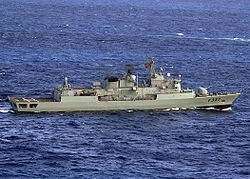
|
NRP Vasco da Gama (F330) NRP Álvares Cabral (F331) NRP Corte-Real (F332) |
3200 t |
Submarines
| Ship class | origin | photo | Ships | displacement | Remarks |
|---|---|---|---|---|---|
| Tridente |
|

|
NRP Tridente (S167) NRP Arpão (S168) |
2020 t |
Patrol boats
| Ship class | origin | photo | Ships | displacement | Remarks | |
|---|---|---|---|---|---|---|
| Ocean patrol boats | ||||||
| Viana do Castelo |
|
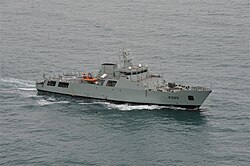
|
NRP Viana do Castelo (P360) NRP Figueira da Foz (P361) NRP Sines (P362) NRP Setúbal (P363) |
1850 t | Six more units planned | |
| Baptista de Andrade |
|
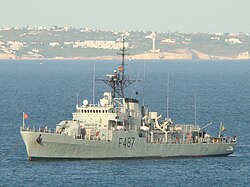
|
NRP João Roby (F487) | 1380 t | Is the Viana do Castelo-class patrol vessel replaced | |
| Coastal patrol boats | ||||||
| Tagus river |
|
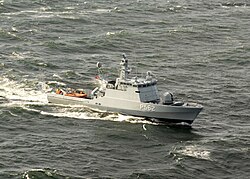
|
NRP Tejo (P590) NRP Douro (P591) NRP Mondego (P592) NRP Guadiana (P593) |
345.8 t | former units of the Royal Danish Navy | |
| Centauro |
|

|
NRP Centauro (P1155) NRP Orion (P1156) NRP Pégaso (P1157) NRP Sagitário (P1158) |
94 t | ||
| Argos |
|

|
NRP Argos (P1150) NRP Dragão (P1151) NRP Escorpião (P1152) NRP Cassiopeia (P1153) NRP Hidra (P1154) |
94 t | ||
| Rio Minho |
|

|
NRP Rio Minho (P370) | 70 t | ||
Aid and training ships
| Ship class | origin | photo | Ships | Remarks | ||
|---|---|---|---|---|---|---|
| Auxiliary ships | ||||||
| rover |
|
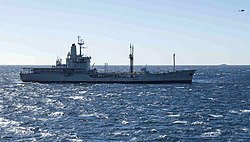
|
NRP Bérrio (A5210) | Tanker - Former British RFA Blue Rover (A270) | ||
| Research Vessels (Hidrográficos) | ||||||
| Dom Carlos I |
|

|
NRP Dom Carlos I (A522) NRP Almirante Gago Coutinho (A523) |
Research Vessel - Former American USNS Audacious (T-AGOS-11) and USNS Assurance (T-AGOS-5) | ||
| Andrómeda |

|
NRP Andrómeda (A5203) NRP Auriga (A5205) |
Research ship | |||
| School ships | ||||||
| Gorch Fock |
|

|
NRP Sagres (A520) | Sail training ship, former Albert Leo Schlageter of the Kriegsmarine | ||
|
|
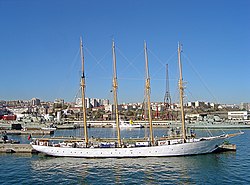
|
UAM Creoula (A201) | Sail training ship | |||
| NRP Zarco | Sailing school boat | |||||
|
|
NRP Polar (A5204) | |||||
| Albatroz |
|
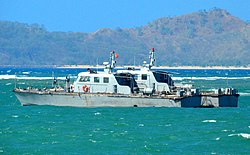
|
UAM Condor (UAM 630) | former patrol boat | ||
Aircraft
Status: end of 2018
| Aircraft | origin | photo | use | version | active | Ordered | Remarks |
|---|---|---|---|---|---|---|---|
| helicopter | |||||||
| Westland Lynx |
|

|
Board helicopter | Lynx Mk.95 | 5 | ||
bases
- Main base of operations: Lisbon-Alfeite (Naval Arsenal Arsenal do Alfeite )
- Support facilities: Porto , Portimão , Funchal , Ponta Delgada , Tróia
- Airfield: Montijo in Lisbon , the Base Aérea Nº 6 of the FAP is shared
Armaments project
It is intended to build another six Viana-do-Castelo-class units and a multi-purpose logistics ship in the next few years .
music
A chapel on board is mentioned as early as the records of Vasco da Gama at the end of the 15th century. The first records of a permanent naval band come from the first half of the 18th century. The first record was made in 1903 and is considered to be the first record release in Portugal. It was made by The Gramophone and Typewriter Ltd. Recorded in Lisbon on April 3, 1903 and pressed in Germany in the same year. The Banda da Armada Portuguesa was under the direction of frigate captain Carlos da Silva Ribeiro when it performed at the 44th Music Show of Nations in Bremen in 2008.
Ranks and Rank Badges
Officers
| Rank group | Flag officers | Staff officers | Subaltern officers | Officer Candidates | ||||||||||
|---|---|---|---|---|---|---|---|---|---|---|---|---|---|---|
| badge | ||||||||||||||
| Rank | Almirante da Armada | Almirante | Vice-almirante | Contra-almirante | Comodoro | Capitão de Mar e Guerra | Capita de Fragata | Capitão-tenente | Primeiro-tenente | Segundo tenente | Guarda-marinha and Subtenente | Aspirants | Cadete | |
| Rank (Bundeswehr) |
no equivalent | admiral | Vice admiral | Rear admiral | Flotilla admiral | Sea captain | Frigate captain | Corvette Captain | Lieutenant captain | First lieutenant at sea | Lieutenant at sea |
Oberfähnrich / Ensign |
Midshipman | |
| NATO rank code | OF-10 | OF-9 | OF-8 | OF-7 | OF-6 | OF-5 | OF-4 | OF-3 | OF-2 | OF-1 | OF-D | |||
NCOs and men
| Rank group | NCOs | Teams | |||||||||
|---|---|---|---|---|---|---|---|---|---|---|---|
| badge | no badges |
||||||||||
| Rank | Sargento-mor | Sargento chef | Sargento-ajudante | Primeiro-sargento | Segundo-sargento | Primerio-subsargento | Segundo-subsargento | Cabo | Primeiro-marinheiro | Segundo-marinheiro | Grumbled |
| Rank (Bundeswehr) |
Chief of Staff | Staff Captain | Chief Boatswain | Captain | Boatswain | Chief mate | Mate |
Oberstabsgefreiter / Stabsgefreiter |
Hauptgefreiter / Obergefreiter |
Private | sailor |
| NATO rank code | OR-9 | OR-8 | OR-7 | OR-6 | OR-5 | OR-4 | OR-3 | OR-2 | OR-1 | ||
literature
Walther Bernecker, Horst Pietschmann: History of Portugal - From the late Middle Ages to the present . Beck, Munich 2008.
Web links
Individual evidence
- ↑ The website of the Portuguese Navy instead stated a sea operation at Cabo Espichel in 1180 as the first deployment of a Portuguese fleet until 2014, but withheld the later defeats (1337, 1373 and 1381 ) against Castilian fleets.
- ^ Fritz Regel: Regional Studies of the Iberian Peninsula , page 19. Göschen'sche Verlagshandlung, Leipzig 1905
- ^ Meyers Konversations-Lexikon, third edition, thirteenth volume, page 130. Verlag des Bibliographisches Institut, Leipzig 1878
- ^ Heinrich Loth: Das Sklavenschiff , page 304. Union Verlag, Berlin 1984
- ↑ Brockhaus' Conversations-Lexikon, thirteenth edition, supplement volume, page 602.Brockhaus, Leipzig 1887
- ^ Meyers Konversations-Lexikon, Fifth Edition, Fourteenth Volume, page 83.Bibliographisches Institut, Leipzig and Vienna 1897
- ↑ Museu da emigração e das comunidades, Luísa Maria Gonçalves Teixeira Barbosa, O Contributo da Comunidade de Portugueses no Brasil para a Consolidação do Republicanismo em Portugal (1890-1910) ( Memento of January 22, 2012 in the Internet Archive )
- ^ Brockhaus - Handbuch des Wissens, Third Volume, page 597. Brockhaus, Leipzig 1923
- ↑ Der Neue Brockhaus, third volume, page 586. Leipzig 1937
- ^ John Pilger: Hidden Agendas , 2010, ISBN 1-4070-8641-3
- ↑ Craig Hoyle: World Air Force 2019. (PDF) Flight International, December 8, 2018, accessed February 11, 2019 .
- ↑ Portugal receives fourth Viana do Castelo-class OPV. In: navaltoday.com. December 31, 2018, accessed February 11, 2019 .
- ↑ Costa anuncia mais sete novos Navios para a Marinha. In: jn.pt. July 20, 2018, accessed February 11, 2019 (Portuguese).



